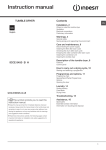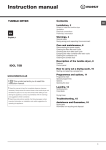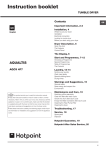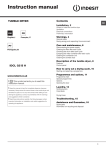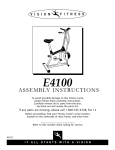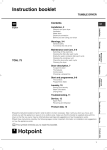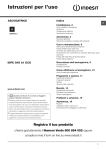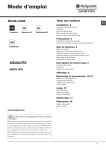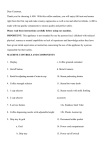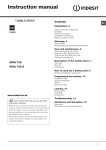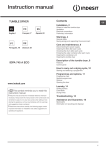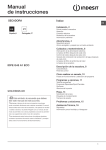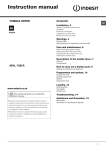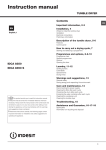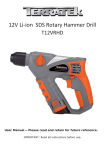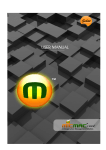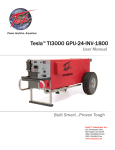Download User Manual
Transcript
Instruction manual TUMBLE DRYER Contents EN Installation, 2 EN English Where to install the tumble dryer Ventilation Electrical connections Levelling the tumble dryer Preliminary information Warnings, 4 General safety Saving energy and respecting the environment Care and maintenance, 6 Disconnecting the power supply Cleaning the filter after each cycle Checking the drum after each cycle Emptying the water container after each cycle Cleaning the Heat Pump Filter Cleaning the tumble dryer IDPE 845 A1 ECO Description of the tumble dryer, 8 Features Control panel How to carry out a drying cycle, 9 Starting and selecting a programme Programmes and options, 10 www.indesit.co.uk This symbol reminds you to read this instruction manual. ! ! Keep this manual at hand for immediate reference whenever necessary. Always store this manual close to the tumble dryer and remember to pass it on to any new owners when selling or transferring the appliance, so they may familiarise with the warnings and suggestions herein contained. ! Read these instructions carefully: the following pages contain Programme chart Special programmes Options Opening the door Laundry, 13 Sorting laundry Care labels Drying times Troubleshooting, 15 Assistance, 16 Information on recycling and disposal Spare parts important information on installation and useful suggestions for operating the appliance. 1 Installation 10 mm • Place your dryer at a distance from gas ranges, stoves, heaters, or cooktops because flames can damage the appliance. The dryer should be installed in an 15 mm 15 mm ambient room temperature of between 20 to 23°C for optimum performance. But will function if the room is between 14 and 30°C. If you are going to install the appliance under a work counter, be sure to leave a 10 mm space between the top and any other objects on or above the machine and a 15 mm space between the sides and lateral furnishings or walls. This is to ensure proper air circulation. The appliance must be installed with the rear surface placed against a wall. Ventilation • When the dryer is in use, there has to be adequate ventilation. Make sure you put your dryer in an environment that is not damp and has proper air circulation throughout. Airflow around the dryer is essential to condense the water produced during the washing, the dryer will not operate efficiently in an enclosed space or cupboard. ! If using the dryer in a small or cold room some condensation will be experienced. !We do not recommend that the dryer is installed in a cupboard but the dryer must never be installed behind a lockable door, a sliding door or a door with a hinge on the opposite side to that of the dryer door. 1 2 2 1 Less than 1m EN existing one as indicated in figure B inserting it in the same place. Where to put your dryer Fig. A Fig. B Water Drain If the machine is positioned close to a drain it is possible to drain the condensed water directly without using the waterbottle. In which case it is no longer necessary to empty the water bottle at the end of each cycle. If the Dryer is positioned above or close to a Washing Machine the same drainage can be used. Just remove the tube indicated in figure A and connect it to the drainage. If the drainage is further away than the length of the tube it is possible to buy and connect a tube of the same diameter and the necessary length in order to reach the drain. To install the new tube just substitute the 2 ! The drain tube has to be below 1 m from the bottom of the Dryer. ! Once the Dryer has been installed please assure that the drain tube is not bent or kinked. Electrical connections Before plugging the appliance into the socket, check the following: • Make sure your hands are dry. • The socket must have an earth connection. • The socket must be able to withstand the machine’s maximum power output as indicated on the rating plate (see Description of the tumble dryer) • The power supply voltage must fall within the values indicated on the data plate (see Description of the tumble dryer). • The socket must be compatible with the dryer’s plug. Should this not be the case, replace the plug or the socket. ! DO NOT USE EXTENSION CORDS. ! The dryer must not be installed outdoors, even if the space is sheltered. It can be very dangerous if exposed to rain or storms. ! Once installed, the dryer’s electrical wire and plug must be within reach. ! The power cord must not be bent or squashed. ! If the plug being replaced is a nonrewirable type, then the cut-off plug must be disposed of safely. DO NOT leave it where it can be inserted into a socket and create a shock hazard. ! The power must be regularly checked. If the supply cord is damaged, it must be replaced by the manufacturer, its service agent or similarly qualified persons in order to avoid a hazard. (see Assistance). New or longer electric cords are supplied by authorised dealers at a supplementary cost. ! The manufacturer denies any responsibility should any of these rules not be followed. ! If in doubt about any of the above consult a qualified electrician. Preliminary information Once the tumble dryer is installed, clean the inside of the drum before operating it and remove any dirt accumulated during transportation. Levelling the tumble dryer The dryer must be installed level for correct operation. When you have installed your dryer in its final location check that it is level first side-to-side, then front to back. If the dryer is not level, adjust the two legs up or down until your dryer is level. Before you start using our dryer Once you’ve installed your dryer and before you use it, clean the inside of the drum to remove any dust that could have accumulated during transportation. Warning ! Before you use your dryer ensure that its has been in a upright position for at least 6 hours. Maximum load sizes: maximum 8 kg EN Product Data - Regulation 392/2012. Brand Indesit Model IDPE 845 A1 ECO (UK) Rated capacity of cotton laundry for the "standard cotton programme" at full load - kg 8.0 This household tumble drier is a Energy efficiency class on a scale from A+++ (low consumption) to D (high consumption) Condenser The weighted Annual Energy Consumption (AEc)* kWh 1) This household tumble drier is a Energy consumption full load; Edry - kWh 2) Energy consumption partial load; Edry½ - kWh 2) Power consumption: off-mode (Po) - Watts Power consumption: left-on mode (Pl) - Watts Duration of the 'left-on mode' for power management system minutes 305.4 Automatic 2.64 1.34 0.14 2.39 A+ 30 Prog. Time - weighted (Tt) full & partial load - minutes 3) Full load (Tdry) - minutes Partial load (Tdry½) - minutes Condensation efficiency class on a scale from G (least efficient) to A (most efficient) Average condensation efficiency - % 173 235 127 weighted (Ct) full & partial load 3) full load (Cdry) partial load (Cdry½) Airborne acoustical noise emissions - dB(A) re 1 pW 71 72 71 69.0 C 1) The "standard cotton” at full and partial load are the standard programmes to which the information in the label and the fiche relates. The standard cotton program is suitable to dry at cupboard level (0%) cotton laundry and is the most efficient programme in terms of energy consumption. Partial load is half the rated load. 2) based on 160 drying cycles of the standard cotton programme at full and partial load, and the consumption of the low-power modes. Actual energy consumption will depend on how the appliance is used. 3) Weighted average of 3 cycles at full load and 4 cycles at half load. Regulation 932/2012. Energy consumption in kWh, for program “Synthetics” full load Programme time in minute, for program “Synthetics” full load 0.92 90 Partial load for program “Synthetics” N/A 3 Warnings EN ! This appliance has been designed and built according to international safety standards. These warnings are given for safety reasons and must be followed carefully. General safety • This appliance can be used by children aged from 8 years and above and persons with reduced physical, sensory or mental capabilities or lack of experience and knowledge if they have been given supervision or instruction concerning use of the appliance in a safe way and understand the hazards involved. • This tumble dryer has been designed for home, and not professional, use. • Do not touch the appliance while barefoot or with wet hands or feet. • Unplug the machine by pulling on the plug, not the cord. • After using the dryer, turn it off and unplug it. Keep the door closed to make sure that children do not use it as a toy. • Children should be supervised to ensure that they do not play with the dryer. • Cleaning and user maintenance shall not be made by children without supervision. •Children of less than 3 years should be kept away from the appliance unless continuously supervised. • The appliance must be installed correctly and have proper ventilation. The air intake at the front of the dryer should never be obstructed (see Installation). • Never use the dryer on carpeting where the pile height would prevent air from entering the dryer from the base. • Check to see if the dryer is empty before loading it. • The back of the dryer could become very hot. Never touch it while in use. • Do not use liquid fabric softeners in the dryer; add it to the final rinse of your wash. • Do not overload the dryer (see Laundry for maximum loads). • Do not load items that are dripping wet. • Carefully check all instructions on clothing labels (see Laundry). • Do not tumble dry large, very bulky items. • Do not tumble dry acrylic fibres at high temperatures. 4 • Do not turn off the dryer when there are still warm items inside. • Clean the filter after each use (see Maintenance). • Empty the Water Container after each use (see Maintenance). • Clean the Heat Pump filter unit at regular intervals (see Maintenance). • Do not allow lint to collect around the dryer. • Never climb on top of the dryer. It could result in damage. • Always follow electrical standards and requirements (see Installation). • Always buy original spare parts and accessories (see Service). To minimise the risk of fire in your tumble dryer, the following should be observed: • Tumble dry items only if they have been washed with detergent and water, rinsed and been through the spin cycle. It is a fire hazard to dry items that HAVE NOT been washed with water. • Do not dry garments that have been treated with chemical products. • ●Do not tumble dry items that have been spotted or soaked with vegetable or cooking oils, this constitutes a fire hazard. Oil-affected items can ignite spontaneously,especially when exposed to heat sources such as a tumble dryer. The items become warm, causing an oxidisation reaction with the oil, Oxidisation creates heat. If the heat cannot escape, items can become hot enough to catch fire. Piling, stacking or storing oil-effected items can prevent heat from escaping and so create a fire hazard. If it is unavoidable that fabrics containing vegetable or cooking oil or those that have been contaminated withhair care products be placed in a tumble dryer they should first be washed with extra detergent - this will reduce, but not eliminate the hazard. They should not be removed from the dryer and piled or stacked while hot. • ●Do not tumble dry items that have previously been cleaned in or washed in, soaked in or soiled with petrol/gasoline, dry cleaning solvents or other flammable or explosive substances. Highly flammable substances commonly used in domestic environments including cooking oil, acetone, denatured alcohol, kerosene, spot removers, turpentine, • • • • • • waxes and wax removers. Ensure these items have been washed in hot water with an extra amount of detergent before being dried in the tumble dryer. Do not tumble dry items containing foam rubber (also known as latex foam), or similarly textured rubber like materials. Foam rubber materials can, when heated, produce fire by spontaneous combustion. Fabric softener or similar products should not be used in a tumble dryer to eliminate the effects of static electricity unless the practice is specifically recommended by the manufacturer of the fabric softener product. ●Do not tumble dry undergarments that contain metal reinforcements eg. bras with metal reinforcing wires. Damage to the tumble dryer can result if the metal reinforcements come loose during drying. ●Do not tumble dry rubber, plastic articles such as shower caps or babies waterproof covers, polythene or paper. ●Do not tumble dry rubber backed articles, clothes fitted with foam rubber pads, pillows, galoshes and rubber coated tennis shoes. ●Remove all objects from pockets such as lighters and matches. EN ! WARNING: Never stop the dryer before the end of the drying cycle unless all items are quickly removed and spread out so that the heat is dissipated. Save energy and respect the environment • Wring out all items to eliminate excess water before tumble drying (if you use a washing machine first, select a high spin cycle). Doing this will save time and energy during drying. • Always dry full loads - you save energy: single items or small loads take longer to dry. • Clean the filter after each use to contain energy consumption costs (see Maintenance). 5 Care and maintenance EN Disconnecting the power supply ! Disconnect the dryer when not in use or during cleaning and maintenance operations. Cleaning the filter after each cycle The filter is a fundamental component of the dryer: its function is to collect lint and fluff that form during drying. Clean the filter once drying is completed, by rinsing it under running water or cleaning it with a vacuum cleaner. Should the filter become clogged, the flow of air inside the dryer will be seriously hampered: drying times becomes longer and more energy is consumed. Moreover, the dryer may become damaged. The filter is located in front of the dryer seal (see Picture). Removing the filter: 1. Pull the filter’s plastic handle upwards (see Picture). 2. Clean the fluff off the filter and replace it correctly. Ensure that the filter is pushed fully home. ! Do not use the dryer unless the filter has been replaced in its holder. Checking the drum after each cycle Rotate the drum manually to remove smaller items (handkerchiefs) that could have been left inside the dryer. Cleaning the drum ! Avoid using abrasives, steel wool or stainless steel cleaning agents to clean the drum. A coloured film may appear on the stainless steel drum surface: it may be caused by a combination of water and/or cleaning agents such as wash-softeners. This coloured film does not affect the dryer’s performance. 6 Emptying the water container after each cycle 2 Remove the water container and empty it into a sink or other suitable drain outlet, then replace it correctly. Always check the water container and empty it before starting a new drying cycle. -Failure to empty the water container may cause the following: - The dryer stops heating (thus the load may still be damp at the end of the drying cycle). - The “Empty water container” LED activates to show that the water container is full. Priming the Water Collection System When your dryer is new, the Water Container will not collect Water until the system is primed, this will take 1 or 2 drying cycles. Once primed it will collect Water during every cycle. Cleaning the Heat Pump Filter Unit • Periodically (every 5 drying cycles) remove Heat pump filter unit and clean any build up of fluff from the surface of the filter by rinsing it under running water or with your vacuum cleaner. We however recommend that you clean this filter after every drying cycle to optimize the dryers performance. To remove Heat pump filter unit: 1. Unplug the dryer and open the door. 2. Remove the filter unit by rotating the 4 clips to the vertical position then pulling the filter unit towards you. 3. Separate the two parts of the filter unit and clean the surface of the filter. ! Warning: The front of the heat pump is made from thin metal plates. Take care that you do not damage these or cut yourself when cleaning, removing or replacing the filter unit. 4.Whenever you clean the Heat pump filter unit always clean any build up of fluff from the surface of the metal plates. Carefully clean this fluff off with a damp cloth,sponge or vacuum cleaner. Never use your • Clean the front air intake grille regularly (every 6 months) with a vacuum cleaner to remove any lint, fluff or dust deposits. Furthermore, remove any lint deposits from the front part of the condenser and from the filter area, using a vacuum cleaner every so often. ! Do not use solvents or abrasives. ! Have the dryer checked regularly by authorised technical personnel in order to ensure that the electrical and mechanical parts work safely (see Assistance). Fingers. 5. Assemble the two parts of the filter clean the surface of the seals and replace with the 4 clips into the horizontal position, sure that the catches have been secured. EN Quick Tips !Remember to clean your filter and Heat Pump filter unit after each load. ! Remember to empty your water container after each load. ! Doing this will keep your machine working at its BEST! Cleaning the tumble dryer • The external metal, plastic and rubber parts can be cleaned with a damp cloth. 2 Water container Filter Air intake Heat pump filter unit Catches Condenser cover Handle 7 Description of the tumble dryer Features Opening the door EN Rating plate Water container Press the door Model & Serial Numbers Filter Heat Pump Filter Unit (cover open) Air intake grille Heat Pump Filter Unit cover handle (Pull here to open) Ajustable feet (to level dryer) Control panel On/Off button Options Timed Drying buttons and indicator lights button Programme selection knob Delay start button Start/Pause button and indicator light Display Clean filter indicator light Clean Heat Pump Filter Empty water container indicator light indicator light Cycle phases Timed drying icon Delay start icon 8 ON/OFF/Reset button Pressing the button normally will cause the machine to switch on or off. If the button is pressed for 3 seconds while the dryer is in use, the machine will switch off and the running cycle will reset. Programme selection knob Allows for setting the programme: turn until the indicator points towards the desired programme (see Starting and selecting a programme). Options buttons Allows selection of the options available for the selected programme. The respective indicator lights turn on when the option has been selected (see Programmes and options). START/PAUSE button and indicator light When the green light flashes slowly, press the button to start the programme. When the cycle is under way, the indicator light remains on. Press the button again to put the programme in the pause mode; the indicator light turns orange and starts flashing again. Press the button again to resume the programme from the point it was interrupted (see Starting and selecting a programme). Display In section A, the selected “Timed drying” value is displayed; if the “Delay start” function was set, the time remaining to the start of the selected programme will appear. The duration of the selected programme is also displayed in this section. In section B, the phase of the running programme is displayed: Sun icon : Drying cycle Fan icon : Cold air cycle In section C, the maintenance indicator lights are displayed (Empty water container indicator light Clean Heat pump filter unit indicator light ), see Indicator lights. , Clean filter indicator light , B C A Indicator lights The indicator lights provide important information. They indicate the following: The “Empty water container” indicator light signals that the water container must be emptied. If the water container fills during the course of the programme, the LED lights up. The dryer automatically starts a cold air cycle and the START/PAUSE LED flashes orange. Press the START/PAUSE button to resume the cycle from the point it was interrupted. In order to avoid this procedure, always empty the water container after using the tumble dryer (see Maintenance). Before each programme, the “Clean filter” indicator light (see Maintenance). The “Clean Heat pump filter unit” indicator light recommend you clean it after each cycle). signals the fundamental importance of cleaning the filter before each load indicates that you must clean the Heat pump filter every 5 cycles (however, we 9 EN How to carry out a drying cycle Starting and selecting a programme EN 1. Plug the dryer into the power supply socket. 2. Select the programme according to the type of laundry (see Laundry). 3. Open the door, ensure that the filter is clean and securely placed and that the water container is empty and correctly slotted (see Maintenance). 4. Load the machine, making sure that no piece of laundry gets between the door and the relative seal. Close the door. 5. Press the ON/OFF button to switch on the machine. 6. After consulting the programme chart and the indications for each type of fabric (see Laundry), turn the Programme selection knob towards the programme corresponding to the type of laundry to be dried (see Programmes and options). ! Warning: If the position of the programme selection knob changes after pressing the START/PAUSE button, the selected programme will NOT be modified. To modify the programme, press the START/PAUSE button to put the programme in pause mode (the indicator light flashes orange), then select a new programme and the relative options. Press the START/PAUSE button to start the new programme. 7. Select the ”Timed Drying” function by pressing the timed drying button until the required time is dispayed (see Programmes and options). 8. If necessary, set the time of the delayed start and any other options (see Programmes and options). 9. Press the ALARM button to sound a buzzer signalling the end of the programme. 10. Press the START/PAUSE button to start the drying cycle. The display will show the approximate time remaining. Laundry can be checked while the drying programme runs and any garments already dry can be removed, while drying continues for the remaining items. After closing the door, press the START/PAUSE button to resume machine operation. 11. The final COOL TUMBLE phase (i.e. the fabrics are cooled) activates during the last few minutes of the drying programme; always allow this phase to terminate. 12. At the end of the drying cycle the display shows END. The buzzer will beep 3 times to let you know that your programme is complete. (Note: If the SOUND option was selected the buzzer beeps 3 times every 30 seconds for 5 minutes). Open the door, remove the laundry then clean the filter and replace it. Empty the water container and put it back in its slot (see Maintenance). If the clothes are not removed at the end of the cycle the automatic Anti Craese action will, on those programmes with this feature, continue to rotate the drum intermittently for up to 10 hours to minimise creasing. Opening the door or pressing the OFF button will stop the Anti Crease action. 13. Disconnect the dryer from the power supply. Automatic pre-post Anti Crease This is an automatic function which provides an anti crease treatment both before and after the drying programme. By periodically rotating the drum before the start of the drying cycle, when a delayed start is selected, the formation of creases is prevented. On certain programmes (see the programme table) the drum also rotates periodically at the end of the drying cycle on. This post crease care action continues until either the door is opened or the OFF button is pressed. Standby mode This tumble dryer, in compliance with new energy saving regulations, is fitted with an automatic standby system which is enabled after about 30 minutes if no activity is detected. Press and hold the ON/OFF button until the dryer reactivates. 10 Programmes and options Programme chart Programme Max. load (kg) Compatible options Cycle duration Energy Saver 1 Memo - Alarm – Delay start. 2 Eco Synthetics 1 Memo - Alarm – Delay start. Cottons 3 Standard Cotton**** Max. High heat* - Fast Iron - Memo - Alarm – Timed drying – Delay start. 4 Ready to Wear Max. High heat* - Memo - Alarm – Timed drying – Delay start. 5 Cotton Hanger Max. High heat* - Memo - Alarm – Timed drying – Delay start. 1 High heat* - Memo - Alarm – Delay start. 7 Easy Mix 3 Memo - Alarm – Delay start. 8 Delicates 2 Fast Iron - Memo - Alarm – Timed drying – Delay start. 9 Wool** 1 Fast Iron - Memo - Alarm. 10 Synthetics 4 Fast Iron - Memo - Alarm – Timed drying – Delay start. 6 Express 45’ Special Care Sport&Leisure 11 Special Shoes** 12 Fitness 13 Jeans 14 Down Jackets 1 pair Memo - Alarm. 4 3 Memo - Alarm – Delay start. Fast Iron - Memo - Alarm – Delay start. 1.5 Memo - Alarm – Delay start. 2.5 Memo - Alarm. - Memo - Alarm. Extra Crease Relax** Freshen Up** The duration of the drying cycles can be checked on the display***. 1 Eco Cotton Note: * just with Timed Drying selected. ** This programme is not compatible with automatic Anti Crease. *** The duration of these programs will depend on the size of the load, types of textiles, the spin speed used in your washer and any extra options selected.**** Standard Cotton is the most efficient program in terms of energy consumption (EU 392/2012). To reach maximum efficiency, select the highest temperature option (Standard/Default starting configuration) Energy Saver Cycles The Energy Saver Cycles reduce energy consumption and so they not only help the environment, they also cut your energy bill! Energy Saver Cycles are available for several different types of fabric, there is one you can use with cottons, there is one specially for shirts and there is one for use with synthetic fabrics. They have all been designed to guarantee excellent drying performance for small loads. Energy Saver Cycles give the best drying results thanks to perfect temperature regulation and to accurate humidity detection which is optimized to obtain the best result on small load. Standard Cotton: Dries your items to a dryness level that allows you to put your clothes away straight from the dryer. Ready to Wear: Dries your items to the maximum possible dryness level. Even drier than Standard Cotton. Cotton Hanger: Dries your items to a dryness level that allows them to finish drying on a hanger in order to minimise ironing. Express 45’ This is a quick timed programme, ideal for drying garments spun at high speed in the washing machine, for example shirts used in a work week. Easy Mix This programme is ideal for drying cotton and synthetic fabrics together. Delicates This is a programme for drying your Delicate Clothes i.e. Acrylics. It can be used for load sizes up to 2.0 kg. Loads dried using this programme are usually ready to use, but on some garments may be slightly damp. If this is found try removing the load and open them out or turn inside out then run the programme again for a short period. Wool Programme This programme is specific for items that withstand tumble drying and are labelled with the symbol. It is suitable for loads of up to 1 kg (about 3 jerseys). We recommend turning the garments inside out before drying them. This programme lasts about 1:00 11 EN EN (hrs:mins), although it may last longer depending on the size and density of the load and on the spin speed used during the wash cycle. Garments dried with this programme are usually ready to be worn, although the edges of heavier garments may be slightly damp. Leave them to dry naturally, as an additional drying process may damage them. Unlike other materials, the shrinking process in wool is irreversible, i.e. the garment does not resume its original dimension and shape. This programme is not suited for acrylic items. Special Shoes Programme This programme is specific for drying sports shoes. The shoes must have been previously washed and spun at a minimum spin speed of 400 revolutions. A specific shoe rack is provided and must be used, otherwise the dryer will be damaged if shoes are dried in the drum. Remove the filter from its holder on the front part of the dryer and position the shoe rack. Place shoelaces inside the shoes then load with the tips of the shoes facing downwards and the soles frontwards. Drying times vary according to the shape and type of the shoe. If the shoes are not completely dry at the end of the programme, restart the programme. ! Do not dry shoes that have gel or flashing lights inside them. Only dry shoes made of synthetic material or rope. Once the programme ends, remove the shoe rack and replace the filter into its holder. Fitness This programme is suitable for safely drying garments such as tracksuits and Fitness suits bearing the up to 4 kg. We suggest turning garments inside out before drying them. symbol. Suitable for loads of Jeans ●This is a programme for jeans made from denim cotton. Before drying your jeans turn the front pockets inside out. ●Do not mix dark and light coloured items. It can also be used on other garments made from the same material, such as jackets. Loads dried using this programme are usually ready to wear, the edges or seams may be slightly damp. If this is the case, try turning the jeans inside out and running the programme again for a short period. ! We do not recommend that you use this programme if your jeans have elastic waist bands, studs or embroidery. Down Jackets A cycle intended to dry down jackets, giving their natural softness back (2 jackets). Crease Relax A short 10-minute programme that relaxes the garment’s fibres in order to facilitate ironing and folding. This programme is particularly recommended for cotton or mixed cotton fabrics. For optimal results, do not overload the drum (the following values refer to the weight of dry garments): Fabric: maximum load Cotton and mixed cotton: 2.5 kg Synthetic garments: 2 kg Jeans: 2 kg Empty the dryer as soon as the programme ends; hang, fold or iron garments then place them in the wardrobe. If this is not possible, repeat the programme. As this is not a drying programme, it is not to be used for garments that are still wet. The effect produced by the programme varies according to the characteristics of the each fabric: fabrics such as acrylic fibres or Tencel® do not give the same results as traditional fibres (e.g. cotton). Freshen Up A short programme suitable for refreshing fibres and garments. It lasts about 20 minutes. ! As this is not a drying programme, it is not to be used for garments that are still wet. ● It can be used on any load size but is more effective on smaller loads. 12 Options EN The options allow for customising the selected programme according to one’s own needs. Timed drying After selecting a programme, press the “Timed drying” button to enter a drying time. Every time this button is pressed, the duration of the selected drying cycle appears on the display. When pressed the first time, the highest allowed value for the selected cycle appears on the display. When pressed each of the following times, the set time is reduced until OFF appears. The buzzer will activate if the timed drying option is not available. Delay Start The start of some programmes (see Programmes and options) may be delayed up to 24 hours. Before selecting a programme with a delayed start make sure that the water bottle is empty and the filter is clean. The drum will rotate occasionally before the drying programme starts to prevent the formation of creases. High Heat When a drying time is selected, pressing this button sets a high heat drying and the indicator light above the button lights up. The timed programmes are pre-set to low heat. Fast Iron This option, when selected, delivers for the cycle chosen the best humidity level to help make ironing quicker and easier. This option stops the cycle at the ideal dryness level for ironing thus making ironing easier and faster. (See programme guide and options). Memo This option allows you to store your cycle selection along with any associated options and to easily use a previously stored cycle. Delayed start options cannot be stored. •Press and hold the button MEMO for 3 second to store a cycle. You can press this button when the desired cycle and associated options have been selected either before the cycle has started or during the drying cycle. When you press and hold the Memo button the LED flashes as well as the time on the display and after 3 second a beep will confirm that the details have been stored. •To recall the stored cycle simply turn on the dryer, press the memo button and then start the cycle. It is possible to change any of the options in the normal way. Every 2 minutes the stored cycle number will appear on the display. If no cycle has been stored you will hear a beep when the Memo button is pressed. •A stored programme can be overwritten with a new programme just by repeating the steps outlined above. Alarm A buzzer sounds at the end of the drying cycle to signal that the programme has ended and the garments are ready to be removed. Not all options are available on all programmes (see Programmes and options). Opening the door If the door is opened (or the START/PAUSE button is pressed) while a programme is running, the dryer stops and the following may occur: • The START/PAUSE button flashes orange. • When a delayed start is running, the delay countdown continues. It is necessary to press the START/PAUSE button to resume the “Delay start” programme. The “Delay start” indicator light flashes and the display visualises the time remaining to the start of the selected programme. • It is necessary to press the START/PAUSE button to resume the programme. The progress indicator lights signal the running phase and the START/PAUSE indicator light stops flashing and turns green. • During the post anti-crease phase, the programme ends. Pressing the START/PAUSE button reactivates a new programme from the beginning. • By turning the Programme selection knob, a new programme is selected and the START/PAUSE indicator light flashes green. This procedure can be used to select the COOL drying programme to cool garments if they are judged to be dry enough. Press the START/PAUSE button to start the new programme. Heat Pump Protection System The heat pump sytem has a compressor protection feature, that operates if you open the door or there is a power disruption or you turn off the dryer. This system will prevent the heat pump compressor from starting for 5 minutes after the door is closed and the programme started. Note: If you have a power cut, switch off the power or remove the plug. When power is restored, plug in the machine, press and hold the ON/OFF button until the dryer reactivates, then press Start/Pause button. 13 13 Laundry EN Sorting laundry Drying times • Check the symbols on the care labels of the various garments to verify whether the garments can be safely tumble dried. • Sort laundry according to the type of fabric. • Empty all pockets and check for loose buttons. • Close zips and hooks and fasten belts and strings without tightening them. • Wring out garments to remove the maximum amount of water possible. Drying times are approximate and may vary depending on the following: Laundry • Amount of water retained by items after the spin cycle: towels and delicate items retain a lot of water. • Fabrics: items of the same fabric, but with different texture and thickness may have different drying times. • Amount of laundry: single items and small loads may take Sorting laundry Drying longer times to dry. ! Do not load the dryer when garments are dripping wet. • Check the symbols on the care labels of the various garments to verify Maximum loadwhether sizes the garments can be safely tumble dried. Do not overload the drum. • The Sortfollowing laundry according to thethe type of fabric. values indicate weight of dry garments: • Natural Empty all pockets and check for loose buttons. fibres: maximum 8 kg • Synthetic Close zipsfibres: and hooks and fasten belts and strings without maximum 4 kg tightening them. Do not overload thetodryer as this result is reduced • !Wring out garments remove the may maximum amount of drying performance. water possible. Drying timesif are approximate and may vary on • Drying: items are to be ironed, they candepending be removed the from following: the dryer while still slightly damp. Items that require complete drying can be left longer. • Amount of water retained by items after the spin cycle: •towels Heat and setting. delicate items retain a lot of water. Temperature room: fabric, the lower of the • •Fabrics: items of the same but the withtemperature different texture room, the longer will take for the dryertimes. to dry clothing. and thickness mayithave different drying Bulk: certain bulkysingle items items require special during the • •Amount of laundry: and smallcare loads may take dryingtoprocess. We suggest removing these items and longer dry. replacing them in the dryer once they have been shaken • Drying: if items to be ironed, they can during be removed out: repeat thisare procedure several times the course from thedrying dryer cycle. while still slightly damp. Items that require of the complete drying can be left longer. ! Do not load the dryer when garments are dripping wet. Care labels Maximum load sizes Always check the care labels, especially when placing Do not overload the drum. garments in the tumble dryer for the first time. Below are the The following values indicate the weight of dry garments: most commonly used symbols: Natural fibres: maximum kg Synthetic fibres: maximum kgdried. May be tumble ! Do not overload the dryer as this may result is reduced Do not tumble dry. drying performance. Care labels • ! Heat setting. Do not over-dry items. All fabrics contain natural helps to keep • Temperature of the room:dampness the lower which the temperature of the them fluffy. room,soft theand longer it will take for the dryer to dry clothing. • The Bulk: certain bulky items require care during the drying times provided refer tospecial the automatic Cupboard drying process. We suggest removing these items and dry programmes. replacing in settings the dryerare once have been shaken The Timedthem drying alsothey indicated to enable you out: repeat procedure severaloption. times during the course to select thethis most suitable timed of the drying cycle. The weight refers to dry items. Tumble dry – high heat. Tumble dry – low heat. Always check the care labels, especially when placing garments in the tumble dryer for the first time. Below are the most commonly used symbols: ! Do not over-dry items. All fabrics contain natural dampness which helps to keep them soft and fluffy. Automatic drying times May be tumble dried. Cottons - High Heat Do not tumble dry. Automatic (hrs:mins) Timed (hrs:mins) Tumble dry – high heat. 1 kg 2 kg Tumble dry – low heat. 0:40-1:00 1:00-1:30 1:00 or 1:30 1:30 Drying times after 800-1000The rpmdrying wash times cyclesprovided refer to the automatic Cupboard dry programmes. drying settings you 4 kg The Timed 5 kg 6 kgare also indicated 7 kg to enable 8 kg to select the most suitable timed option. The weight refers to dry items. 1:40-2:10 2:10-2:40 2:40-3:0 3:00-3:10 3:10-3:40 3 kg 1:30-1:40 1:30 or 2:00 2:00 or 2:30 2:30 2:30 or 3:00 3:00 or 3:40 3:40 Synthetics - Low Heat Drying times on reduced spin in washing machine 1 kg 2 kg 3 kg 4 kg Automatic (hrs:mins) 0:40 - 0:50 0:50 - 1:00 1:00 - 1:30 1:20 - 2:00 Timed (hrs:mins) 0:40 or 1:00 0:40 or 1:00 1:00 or 1:30 1:00 or 1:30 or 2:00 Acrylics - Low Heat Drying times on reduced spin in washing machine 1 kg 2 kg Automatic (hrs:mins) 0:40 - 1:20 1:20 - 2:20 Timed (hrs:mins) 0:40 or 1:00 or 1:30 1:30 or 2:00 or 2:30 14 Troubleshooting If you feel that the dryer is not working properly, consult the following troubleshooting suggestions before contacting the Technical Assistance Centre (see Assistance). EN The dryer does not start. • The plug has not been inserted far enough into the socket to make contact. • There has been a power cut. • The fuse has blown. Try connecting another appliance to the same socket. • If an extension cord is used, try connecting the dryer plug directly into the socket. • The door has not been closed properly. • The programme has not been set correctly (see How to carry out a drying cycle). • The START/PAUSE button has not been pressed (see How to carry out a drying cycle). • On machines equipped with “Locked” function, check the option is not enabled (see Programmes and options). The drying cycle does not start. • A delayed start time has been set (see Programmes and options). • The START/PAUSE button has been pressed; a short delay follows before the dryer starts running. Wait for the drying cycle to start; do not press the START/PAUSE button otherwise the dryer switches to the pause mode and the drying cycle will not start. Drying times are too long. • The filter has not been cleaned (see Maintenance). • The water container must be emptied? The “Empty water container” indicator light flashes and the message appears “H2O” (see Maintenance). • The Heat Pump Filter needs cleaning (see Maintenance). • The heat setting is not suited to the type of fabric to be dried (see Programmes and options). • An incorrect drying time was selected for the type of load (see Laundry). • The items are too wet (see Laundry). • The air intake grille are clogged up (see “Installation” and “Care and Maintenance”). • The dryer is overloaded (see Laundry). The “Empty water container” indicator light flashes, but the dryer has been running for a short time. • The water container was probably not emptied before starting the programme. Do not wait for the signal for emptying the water container, but always check and empty it before starting a new drying programme (see Description of the tumble dryer). The “Empty water container” indicator light is on but the water container is not full. • It is normal: the “Empty water container” indicator light flashes when the water container is full. If the indicator light is on but is not flashing, it is just a reminder to empty the container (see Description of the tumble dryer). The programme is finished but the items are damper than expected. ! For safety reasons, the dryer programmes last a maximum of 5 hours. If an automatic programme has not detected the final dampness level required in this interval, the dryer completes the programme and stops. Check the above points and repeat the programme; if the items are still damp, contact the Technical Assistance Centre (see Assistance). The code “F” appears on the display followed by one or two numbers, the options indicator lights and the pause indicator light flash. • If the display shows a fault, switch the appliance off and unplug it, then clean the filter and the Heat Pump Filter unit (see Maintenance). Reinsert the plug, switch the appliance on and start another programme. If the display still visualises a fault, contact the Technical Assistance Centre (see Assistance). If the display still visualises other numbers, mark the code and contact the Technical Assistance Centre (see Assistance). “dOn” briefly appears on the display every 6 seconds. • The appliance is in “Demo” mode. Press the ON/OFF and START/PAUSE buttons and keep them pressed for 3 seconds. The display visualises “dOn” for 3 seconds, then the dryer starts functioning normally. The “Remaining time” indicator changes during the drying cycle. • The remaining time is constantly monitored during the drying cycle and is updated to show the best forecast. It is normal for the displayed time to increase during the cycle. The dryer is noisy during the first few minutes of operation. • This is normal, especially if the dryer has not been used for a long time. If the noise persists during the entire cycle, contact the Technical Assistance Centre. The lights on the dryer control panel are off although the dryer is switched on. • The dryer has gone into standby mode to save power. This occurs if you have left the dryer on or have had a power cut. It occurs after 30 minutes: - if you leave the dryer without starting a programme; - after your drying programme has finished. Press the On/Off button and the lights will come on again. 15 Assistance 02/2015 - Xerox Fabriano EN Heat Pump System This dryer is fitted with a sealed heat pump system to dry your clothes. To operate, the heat pump contains fluorinated greenhouse gases ( F gases) which are covered by the Kyoto Protocol. These F gases are contained in a hermetically sealed unit. This sealed unit contains 0.29 kg of the F gas R134a which acts as a refrigerant. If the sealed unit fails then it must be replaced by a new sealed unit. Contact your nearest service centre for advise. Note: The gases contained in the sealed unit are not hazardous to health, but if they escape they will have an impact on global warming. Provide the following data when contacting the Technical Assistance Centre: • name, address and postal code • telephone number • type of malfunction • date of purchase • the appliance model (Mod.) • the dryer’s serial number (S/N) This information can be found on the data plate located behind the door. Before calling the Technical Assistance Centre: • Follow the troubleshooting guide to check whether problems can be solved personally (see Troubleshooting). • If not, switch the dryer off and contact the Technical Assistance Centre closest to you. This dryer is a complex machine. Attempting to repair it personally or with the aid unqualified personnel may put the safety of people at risk, damage the machine or invalidate the spare parts guarantee. Always contact a qualified technician when experiencing problems with this machine. Please note that it is an offence for an unqualified person to undertaken any servicing or repair work that involves breaking into the sealed heat pump unit. Indesit Company S.p.A. Viale Aristide Merloni, 47 Spare parts 60044 Fabriano (AN) Essential Contact Information INDESIT SERVICE - Service You Can Rely On At Indesit we pride ourselves on offering our customers the best service we possibly can, wherever you are in the UK and Ireland. Rest assured though, no one knows an Indesit appliance better than we do and our service is second to none… Wherever you are we can be there – we have over 1,000 highly skilled Indesit engineers covering the whole of the UK and Ireland ensuring fast, reliable, local service. ‘Right first time’ – our engineers have the latest tools to help get your Indesit appliance back up and running the first time we visit. Experts in our field – all of our engineers are trained to the highest standard at our Training Centre of Excellence and possess unrivalled expertise and product knowledge. Skilled staff – we have over 400 skilled UK based call centre staff, dedicated to offering you excellent service 364 days a year. Telephone in the United Kingdom: 03448 224 224 Telephone in the Republic of Ireland: 0818 313 413 Please note: Our advisors will require the following information: Information on recycling and disposal • model number As of our continual the right to use recycled quality components to • part name, address andcommitment postal codetowards environmental protection, •we reserve serial number reduce costs for our customers and to minimise materials wastage. telephone information can be found on the data plate located •• Disposing of number the packaging materials: follow local regulations to allowThis for recycling of packaging materials. the door. •• In order minimise the risk of injury to children, remove the door andbehind plug, then cut the power supply cord flush with the appliantype oftomalfunction ce. Dispose of these parts separately to prevent the appliance from being connected to a power supply socket. • date of purchase Disposal of old household appliances The European Directive 2012/19/EC on Waste Electricaland Electronic Equipment (WEEE), requires that oldhousehold electrical appliances must not be disposedof in the normal unsorted municipal waste stream. Old appliances must be collected separately in order tooptimise the recovery and recycling of the materialsthey contain and reduce the impact on human healthand the environment. This dryer has a sealed heat pump unit containing Fgases which should be recovered and destroyed.The crossed out “wheeled bin” symbol on theproduct reminds you of your obligation,thatwhen you dispose of the appliance it must beseparately collected.Consumers should contact their local authority orretailer for information concerning the correct disposalof their old appliance. This appliance conforms to the following EU directives: - 2006/95/EC (Low Voltage Directive) - 2004/108/EC (Electromagnetic Compatibility Directive). 16
















